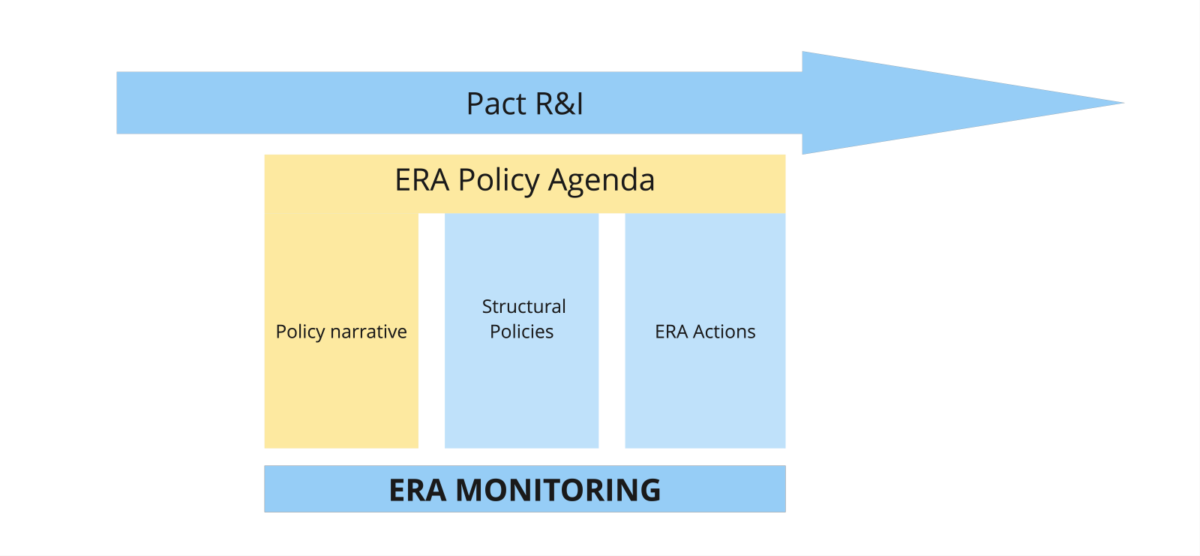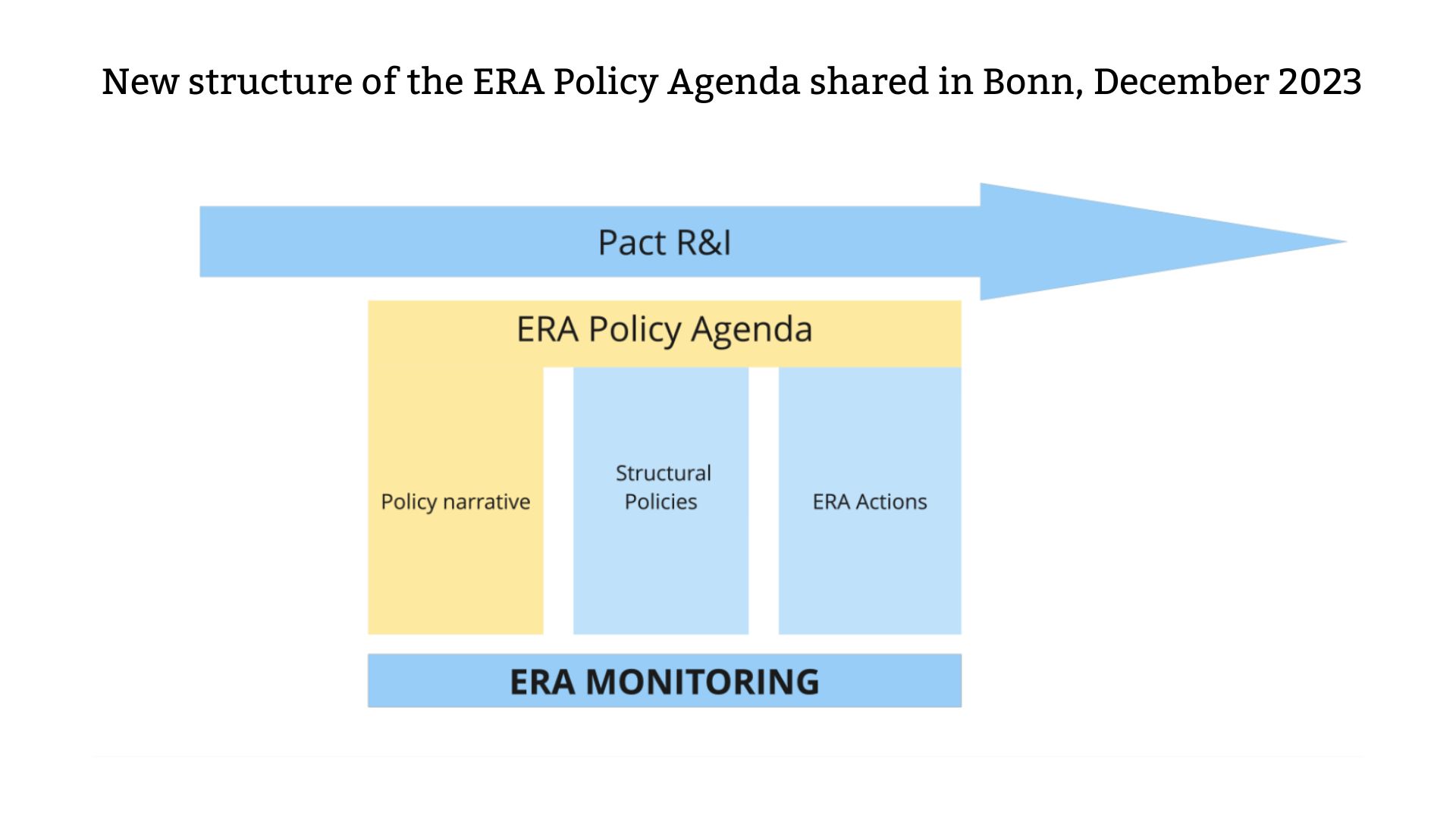Following extensive exchanges and collaborative work among ERA Forum stakeholders on the structure of the next ERA Policy Agenda (EPA), an agreement was finally reached at the ERA Forum meeting of 13-14 December 2023, closing the year with a solid basis upon which to build the future EPA 2025-2027.
The agreed structure retains the EU Pact for R&I as the overarching set of objectives that the EPA aims to achieve. Furthermore, the EPA would now be supported by a strong policy narrative outlining the political context and ensuring linkages between the Pact for R&I and the progress made.
“One of the main challenges of the current EPA is the mixed nature of actions: some point out to very clear challenges, while others focus on wider, structural issues; some are implemented by already existing governance structures, while others have started from scratch and thus require a more dedicated involvement. Considering this, the upcoming EPA 2025-2027 would consist of Actions and Structural Policies. “Actions” are time-bound, outcome-oriented and with a clear beginning and end, while “Structural policies” would focus on structural bottlenecks to the development of ERA and would have a longer-term approach with a stronger dialogue/peer learning component.”
Silvia Gomez Recio, YERUN Secretary General
Visually, the new structure corresponds to the following scheme:

Visual for the new structure of the ERA Policy Agenda shared in Bonn, December 2023.
In January, ERA Forum members (which includes stakeholders as observers) were invited to take a survey to assess the proposed 31 actions to the next EPA. In the survey, questions asked for possible gaps within the Pact R&I, a required action at the level of the ERA Forum, and a selection between Structural Policies, New Actions or other activities as the tools to implement the proposals. While the exercise has been very useful to make sense of all the proposals and will help to give an overview of where the main interest from Member States and stakeholders lies, it will require further dialogue and agreement on what the new elements of the structure mean concretely and how they should complement each other.
Building on the understanding that was shared at the latest ERA FORUM meeting in Bonn, we would like to share our understanding on the different parts of the new EPA. For that, we have included some descriptions of the different sections proposed, intending for them to contribute further to the discussion.
- POLICY NARRATIVE: this is the basis on which the EPA is built. Enshrined in the EU Pact for R&I and the “priorities for action” agreed by Member States as the values and objectives that the EPA should aim to achieve, it provides strategic steering to the ERA Forum. Any New Action, Structural Policy or Governance Structure that enters in the EPA should be connected to one or more priorities of the Pact.
- ACTIONS are clearly time-bound and outcome-oriented. As such, they have a clear beginning and an end, aiming to achieve their concrete outcomes (such as new legislation, policies, strategies, frameworks or funding mechanisms) within the 3 years of the EPA, after which they finish or would evolve into new actions. These are typically topics for which there is a specific gap to fill and concrete actions to follow, and whose understanding of challenges and aspects for joint action within the R&I community are very clear. At the end of the EPA in which they are developed, the ERA Forum can decide whether to propose a follow-up action or not, depending on the specific contexts and outcomes achieved. Actions should be regularly featured in the ERA Forum meetings where progress needs to be discussed and reported regularly, and the active involvement of the members of the ERA Forum is required for its successful completion.
- STRUCTURAL POLICIES, on the other hand, cannot possibly be exhausted in 3 years time: their relevance overcomes the temporal limits posed by the EPA, and therefore requires a much-longer term approach. As their name suggests, they concern policy topics whose nature is indeed “structural to ERA”, meaning that they relate to the system in which we are operating as R&I actors and therefore need to be managed over a longer period of time with a more holistic set of resources and activities. Given their structural nature, they require a continuous dialogue among Member States, Commission and Stakeholders to advance towards their ever-evolving objectives. Important is to note that while structural policies may seem less concrete, they should be clear on the activities that they will carry out in the 3-year period of the EPA, with a connection to past and future work done and how this contributes to the objectives of the Pact that it is addressing. Structural Policies may follow different working methods from the ERA Actions and a continuous involvement by all ERA Forum members might not be needed. In this category we see activities as well that have their own governance structures (see definition below of governance structures). A key example we see under structural policies is the topic of Careers. We cannot just stop discussing the topic of Research Careers after 2024, nor 2027. While acknowledging that process has been made within Action 4 in the current EPA, the persistent challenges in the pursue of an ERA for researchers are far from being achieved and we would fall short if the dialogue on careers would stop after Action 4 is finished. Within this category the establishment of high-level expert groups may be envisaged, including activities such as of mappings, workshops, dialogues, recommendations, etc., with the objective of further pursuing in the advancements of a more general objective.
- GOVERNANCE STRUCTURES can be considered within the Structural Policies, in that they concern “structural topics” (such as research assessment, research infrastructures or Open Science). However, the key difference with the Structural Policies as described above is that they can rely on already existing structures (such as CoARA, ESFRI and EOSC) with their own governance models, strategies, Action Plans and resources for their implementation. As such, in principle, they do not need the ERA Forum for their implementation, but definitely need to develop strong communication channels with the ERA Forum to ensure smooth communication given that they aim to achieve the same ultimate goals as set in the Pact for R&I. Furthermore, governance structures could generate new actions whenever they see the need to propose new legislations, strategies or financing mechanisms.
“YERUN looks forward to continuing sharpening the ERA Forum and its working methods for a more meaningful engagement, collaboration and co-creation among Commission, Member States, Associated Countries and Stakeholders towards developing a stronger European Research Area in the coming years.”
Silvia Gomez Recio, YERUN Secretary General










